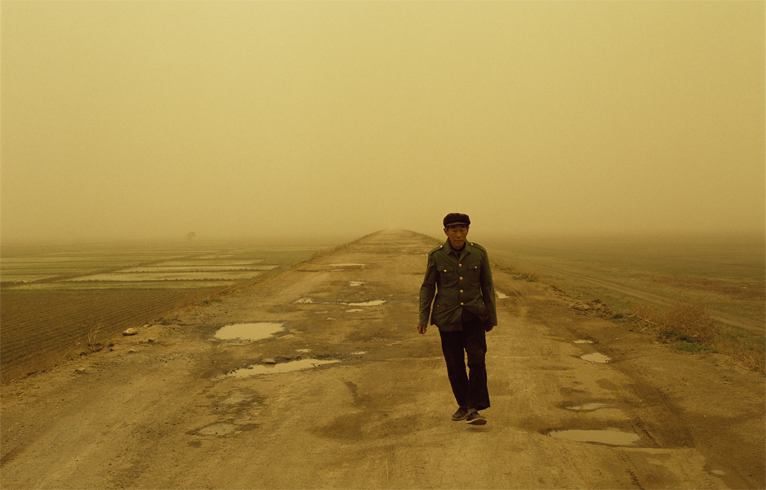HAI BO
| May 27, 2011 | Post In LEAP 8

American photographer Paul Strand once said, “The material of the artist lies not within himself nor in the fabrications of his imagination, but in the world around him…The artist’s world is limitless. It can be found anywhere far from where he lives or a few feet away. It is always on his doorstep.” Embracing Strand’s limitlessness notion of the “world around,” the work on display in Hai Bo’s eponymous outing at Pace/MacGill offers the world of Hai’s hometown to us in all its lush and nostalgic grandeur.
Hai Bo’s show consists of nine large-scale photographs taken by the artist during visits to his mother’s hometown of Changchun, Jilin Province, between 2007 and 2009. The artist frequently returns to Changchun to create work, leaving his adopted home of Beijing behind. To the viewer, the pastoral stillness of the Changchun countryside offers a welcome respite from ubiquitous images of China’s frenetic urbanization. Entering the space feels like one has entered an area of contemplation and repose. Most of the photographs feature a human figure, often people from the artist’s past. Themes in the artist’s work are stripped down to the basics— nature, humans, nostalgia, and the way that time has of irrevocably changing all three.
Staging these themes against the backdrop of his youth, the photograph Old Man captures the sorrow and loneliness of growing old. In the scene, an elderly man dressed in worker’s clothes stands in a desolate forest and leans his head against a tree. The scene carries a certain gravitas: the man is either reflecting on a life well lived or pondering a future when he will return to the earth and rejoin the nature that surrounds him.
Like the figure in Old Man, many of the individuals in Hai Bo’s photographs appear as though they could just as easily be workers from a past dynasty as people of the twenty-first century. Passing Traveler, for example, depicts an older man emerging from a murky, sepiatoned fog, walking down a dirt road toward the viewer. The man is caught mid-step, one foot off the ground in a suspended state, while the road tapers off into the horizon behind him. The vacuum around the figure hints that the man has no destination, and the air feels weighted with a suspended sense of timelessness.
Hung across from this peripatetic walker is a striking portrait of Hai Bo’s uncle, anonymously titled Untitled 6. Cloaked in chiaroscuro, the artist’s uncle appears to us like an oil portrait from the seventeenth century; the fleck of light coming off his pupil appears as though the artist had applied a swatch of gleaming white paint with a palette knife. This work is as much about capturing the personality of the elderly man through the careful depiction of attributes— the subject is accessorized with wizened face wrinkles, a blue worker’s hat, and a playful headphone in one ear—as it is a study of the formal qualities of lightness and dark.
Shadows-2 and Shadows-3 are extensions of the artist’s fascination with light and dark. The powerful works depict a corner of the interior of the artist’s old painting studio, complete with a still life of a skull on a table. At first glance, it would be easy to interpret the presence of this skull as a straightforward memento mori, but it is not that simple. While the passage of time pervades the work, further contemplation of the image, not to mention the title itself, reveals the artist’s fascination with light and space. Light streams through the window, leaving patterned shadows that resemble Paul Strand’s photographs of abstracted shadows cast through window blinds from a century before.
In a moment when many Chinese contemporary artists are looking to their country’s modernization for inspiration, the photographs on display in Hai Bo’s show stand as a lyrical memorial to the endurance of time and nature. Even in these extraordinary times, they seem to suggest, some things remain constant.
Alessandra Henderson

